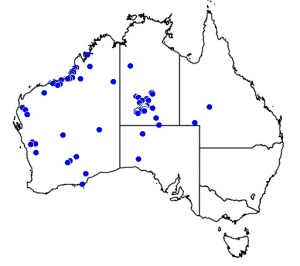Colours
Distinguishing features
They are members of the Acanthophis genus: highly venomous elapids with short and thick bodies, triangular heads, mobile fangs, and a thin tapering tail. They have a flattened appearance. Desert death adders are coloured brick-red, or yellow-reddish, with strong or inconspicuous yellow bands which are camouflaged with their surroundings. The tail tip is used as a lure to attract potential prey and is distinctively darker in colour. Their fangs are longer than most of Australia’s venomous snakes. (Wikipedia)
Size
- Up to 70 cm (Length of specimen)
Synonyms
Distribution
Distribution and habitat preferences
It occurs from the coast of Western Australia, to central regions as far south as Kalgoorlie and into the Northern Territory.
They are found in living in remote areas, amongst porcupine grass, stony flats, sandy ridges and rocky outcrops of Central and Western Australia. In southwest Australia they occur in hummock grass in mallee. (Wikipedia)
Behaviour
It only bites if the threat is very close to them. They also use their bite to catch their prey. They only bite when they are close to their target. They are usually most active after dark, only occasionally being seen during the day. They may climb shrubs or grasses to bask in the morning, and are seen on roads near outlying urban areas. (Wikipedia)
Diet
They feed on lizards, especially skinks and dragons, and small mammals. (Wikipedia)
Web resources
Danger
- rarely fatal - They are reluctant to bite unless the threat is very close to them. However, they have large fangs, and their glands produce a considerable quantity of toxic venom. Today, it rarely is the cause of snake bites in Australia though they are regarded as very dangerous. The venom is most significantly neurotoxin, which once had a 50% mortality rate. (Wikipedia) (Swan 1999)
References
- Gerry Swan (1999). A Photographic Guide to Snakes and other Reptiles of Australia 144 pp. New Holland Publishers, Sydney, Australia.

